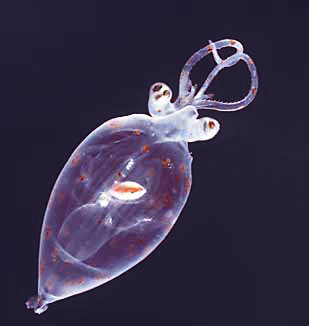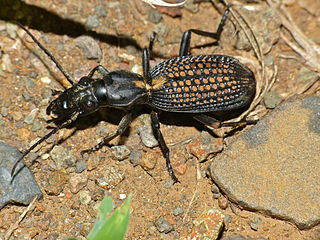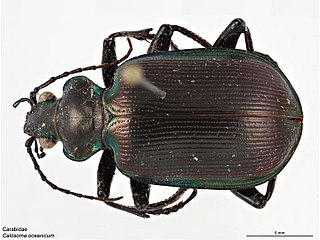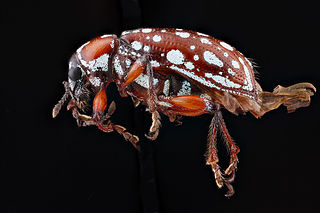
The family Cranchiidae comprises the approximately 60 species of glass squid, also known as cockatoo squid, cranchiid, cranch squid, or bathyscaphoid squid. Cranchiid squid occur in surface and midwater depths of open oceans around the world. They range in mantle length from 10 cm (3.9 in) to over 3 m (9.8 ft), in the case of the colossal squid. The common name, glass squid, derives from the transparent nature of most species. Cranchiid squid spend much of their lives in partially sunlit shallow waters, where their transparency provides camouflage. They are characterised by a swollen body and short arms, which bear two rows of suckers or hooks. The third arm pair is often enlarged. Many species are bioluminescent organisms and possess light organs on the undersides of their eyes, used to cancel their shadows. Eye morphology varies widely, ranging from large and circular to telescopic and stalked. A large, fluid-filled chamber containing ammonia solution is used to aid buoyancy. This buoyancy system is unique to the family and is the source of their common name "bathyscaphoid squid", after their resemblance to a bathyscaphe. Often the only organ that is visible through the transparent tissues is a cigar-shaped digestive gland, which is the cephalopod equivalent of a mammalian liver. This is usually held in a vertical position to reduce its silhouette and a light organ is sometimes present on the lower tip to further minimise its appearance in the water.

Anthia is a genus of the ground beetle family (Carabidae) from Africa and Asia. Species of Anthia can spray a jet of formic acid up to 30 centimetres (12 in), which, if not treated, can cause blindness in animals that harass the beetles.

Monochamus is a genus of longhorn beetles found throughout the world. They are commonly known as sawyer beetles or sawyers, as their larvae bore into dead or dying trees, especially conifers such as pines. They are the type genus of the Monochamini, a tribe in the huge long-horned beetle subfamily Lamiinae, but typically included in the Lamiini today.

Blethisa is a genus in the beetle family Carabidae. There are about nine described species in Blethisa, found in the Holarctic.

Stenolophus is a genus of beetles in the family Carabidae. There are more than 190 described species in the genus Stenolophus.

Anthiinae is a subfamily of beetles in the family Carabidae, containing the following genera:

Cypholoba is a genus in the beetle family Carabidae. There are more than 60 described species in Cypholoba, found in Africa.
Vata is a genus of beetles in the family Cicindelidae, containing the following species:
Crasodactylus is a genus in the beetle family Carabidae. There are at least two described species in Crasodactylus.
Piezia is a genus of beetles in the family Carabidae, containing the following species:
Dromidea is a genus of beetles in the family Carabidae, containing the following species:

Dicaelus is a genus in the beetle family Carabidae. There are about 18 described species in Dicaelus, found in North America.

Dicrochile is a genus of beetles in the family Carabidae, containing the following species:

Sphodrosomus is a genus of beetles in the family Carabidae, containing the following species:

Callidium is a genus of beetles in the family Cerambycidae, containing the following species:
Periboeum is a genus of beetles in the family Cerambycidae, containing the following species:

Calosoma oceanicum is a species of ground beetle in the subfamily of Carabinae. It was described by Perroud & Montrouzier in 1864.
Nemaschema is a genus of longhorn beetles of the subfamily Lamiinae, containing the following species:

Paraepepeotes togatus is a species of beetle in the family Cerambycidae. It was described by Perroud in 1855, originally under the genus Monohammus. It is known from Papua New Guinea, Australia, and Moluccas.

Lachnopus is a genus of broad-nosed weevils in the family Curculionidae distributed in the Caribbean Region.














